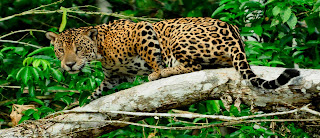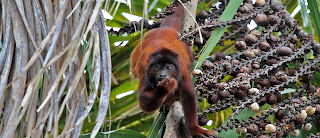Exuberant is the word that describes Madre de Dios with its infinite forests, sinuous rivers that rush towards the ocean, and life abounding in all its corners. Puerto Maldonado, the capital city, is an obligatory stop along the way to gain entrance to the national parks and reserves located in the area, and it has been, at certain moments, an important exporting site for rubber, wood, gold, and petroleum. At present, two of the main economic activities there are eco-tourism and chestnut harvesting
At only ten kilometers from Puerto Maldonado, or a one and half hour hike, you find Lake Sandoval, bordered by aguajales (swampy areas full of palm trees), orchids, kapok trees, caoba trees, and Mauritanian palm trees that grow up to thirty meters tall. The lake is also the home for a large variety of species such as toucans, macaws, parrots, egrets, tapirs, turtles, and the refuge for river otters and black caimans, two species on the brink of extinction. In the areas around Lake Valencia, 60 kilometers from Puerto Maldonado by the Madre de Dios River, there are several indigenous communities where the people make their living from fishing for tiger shovelnose catfish, gilded catfish, and paiche; this area is the habitat for plenty of flora and fauna, too.
COLlPA DE GUACAMAYOS DE COLORADO - SANDOVAL LAKE
Inside the Tambopata National Reserve and 150 km / 93 miles from Puerto Maldonado (12 hours by boat) The “collpa” (macaw clay lick) is a place where macaws congregate, formed along the shores of the river due to certain erosion processes that allowed the formation of soil rich in mineral salts. It is approximately 50 meters / 164 feet high, 500 meters / 1640 feet long, and is considered the largest in the Peruvian Amazon Rainforest. Every morning, six different species of macaws, parrots, and parakeets gather there. These colorful birds fly around the colpa before starting the “colpeo”, which consists in eating the clay found on the cliff and serves as a nutritional supplement. After staying there from twenty-five to thirty minutes, they fly away to come back the next day. Occasionally, Brazilian tapirs, capybaras, and squirrels go there. At the top of the trees, different species of monkeys like the red howler, the caupuchin, the titi, and sometimes even spider monkeys can be seen.
SANDOVAL LAKE:
Sandoval lake 10 km / 6 miles from Puerto Maldonado (25 minutes by a 55 HP boat). To reach the lake, you must walk 5 km / 3 miles from the shore of the river to the interior (1 hour and 30 minutes) It is approximately 3 km / 2 miles long, 1 km / 0,6 miles wide, and 0.5 centimeters / 0,1 inches to 3 meters / 10 feet deep. The water remains at an average temperature of 26ºC (79.8ºF), and a huge amount of fish live there. It is surrounded by aguajales, swampy areas where, among other exotic species, a native palm tree called aguaje grows. Along with the local vegetation, you can see orchids, wild plantains, and milpesos palms, giant kapoks, mahoganys, and 30 meter / 98 feet aguaje palm trees. In this habitat lives a great variety of birds, like cormorants, toucans, macaws, parrots, horned screamers, and herons. In addition, there is a colorful variety of wild hens called hoatzin or shansho whish heads are topped with feathers. With some luck, tapirs, turtles, and giant otters or “river wolves” can be seen as well as different species of crocodiles, like the black caiman.
VALENCIA LAKE:
Valencia Lake 60 km / 37 miles from Puerto Maldonado (4 hours by 55 HP boat) The lake is 15 km / 9 miles long, 800 meters / 2625< feet wide, and between 0,5 and 15 meter / 1,6 and 49 feet deep, and thanks to its trees and fish, it is considered a privileged spot.] Around the lake, there are trees like the pumaquiro, the quinilla, the cedar, the giant kapok, the dwarf fan palm tree, and the Brazil nut tree. Among its animal life, the more exotic are bearded guans, turtles (charapas and big headed motelos), crocodiles, monkeys, cormorants, and herons. The wealth of its waters allows both the Huarayos natives and the settlers of its surrounding areas to make a living from fishing for tiger shovelnose catfish, palometas, gilded catfish, piranhas, and paiches. These last ones, though, are not a native species but were brought to the lake. Along with fishing, another important economic activity is the collection of Brazil nuts.
BAHUAJA-SONENE NATIONAL PARK:
Manu Park 90 km / 56 miles from Puerto Maldonado (4 to 5 hours in a 55 HP boat). This national park was established in order to protect the only tropical humid savanna that exists in Peru. The park is located between the Madre de Dios and Puno departments in the provinces of Tambopata, Carabaya, and Sandia. It has an area of 1’091.416 hectares, and part of it is in Bolivia. The most important animals that can be found there are the maned wolf, the marsh deer, the giant anteater, the river wolf or giant otter, the bush dog, the black caiman and the harpy eagle.
TAMBOPATA NATIONAL RESERVE:
Tambopata 45 km / 28 miles south of Puerto Maldonado (2 hours by motorboat). There is also an alternative route: 25 km / 16 miles by land (by 4x4 vehicle) to the community of Infierno and then a river crossing to the reserve (2 hours by 55 HP motor boat) Located between the basins of the Tambopata and Heath Rivers, the reserve covers an area of 274.690 hectares and is found in both the Madre de Dios and Puno departments. The wealth of its biodiversity is immeasurable, and scientist have already registered 632 bird species, 1200 butterfly species, 169 mammal species, 205 fish species, 103 amphibian species, and 67 reptile species. The vegetation is typical of tropical regions. To enter the reserve, prior authorization from INRENA is required.






No hay comentarios:
Publicar un comentario